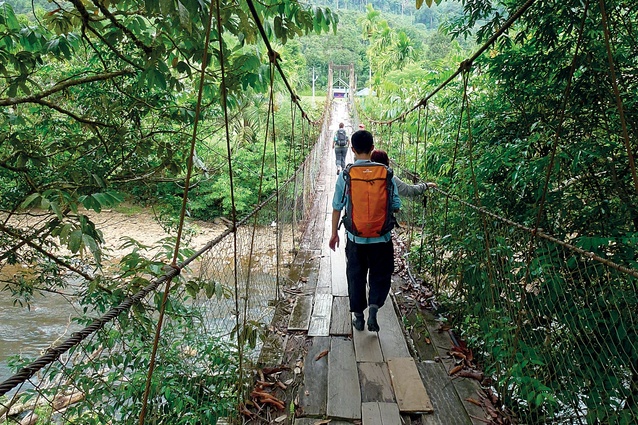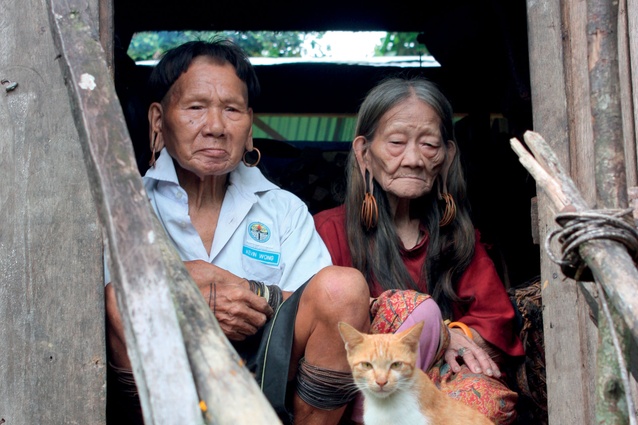People of the forest
In order to fully appreciate and even begin to understand the spiritual and material aspects of a cultural landscape it is necessary to engage in an active exchange with both people and landscape.
This year, Unitec students studying for a Bachelor of Landscape Architecture experienced the cultural landscape of the Penan within the Sarawak rainforest of Malaysia. Although often viewed as wilderness, the rainforest is a place that illustrates the human-nature interaction at its most intimate and the patterns in the landscape that were and are being created as a consequence of this interaction. In Sarawak, this involved an exploration of tourism, forestry and dam issues and their impact on indigenous peoples, and required an intimate experience of the opulent sensory palette of the rainforest environment and the lives of the Penan.
Rainforests are often viewed as natural and pristine environments with recent influence from human interaction, but this belief belies the reality that within their long history, these tropical environments have been host to a range of human societies that have influenced, modified and interacted with the complex ecosystem in which they lived.
Human beings have lived in South-east Asia for a long time and there are a large variety of indigenous peoples found within the region. The Penan are one of these peoples who, for thousands of years, have lived their lives within the rainforest and until the 1950’s were a nomadic tribe that moved through their forest home following resources such as wild animals, fruit and sago palm (their main source of carbohydrate prior to settlement).
Gardening now carried out by the Penan villagers is a new phenomenon as they previously never practiced agriculture, instead depending on wild populations of sago palm. Despite this move to settlement, they still live within the rainforest and express some of the cultural relationships between themselves and their environment.
As generations of people have lived over time in the same place, they have evolved unique world views. Adherence to values such as stewardship and land tenure have tempered the immediacy of exploitative practices and reactionary planning (Jojola 2014). It is these values that provide the most useful wisdom for consideration of sustainable approaches to landscape change and the Penan, in particular, illustrate these values. “For the Penan the forest is alive, pulsing, responsive in a thousand ways to their physical needs and their spiritual readiness” (Davis 1991, p1).
Students discovered in their time with the Penan that design in their rainforest context is not a specialist skill (as it is in western society). Instead, it is a major part of their way of life, embedded within the society and linked to every daily activity they undertake. Design is a learned skill in Penan culture that is more absorbed than it is explicitly taught. Penan utilise the products of the forest in every aspect of their lives, despite their recent move from nomadic to settled. This can be seen in their placement of agricultural gardens over an hour’s walk from the village itself as it is seen to be vitally important to keep the integrity of the forest ecology that surrounds the village as it is utilised so significantly for their livlihood and spiritual wellbeing.
Creativity in the rainforest is heightened due to the demands of that environment. An example is the huge array of designs that have been developed for woven baskets, hats, mats, backpacks, fish traps and personal adornments and tools. The rainforest is an abundant supplier of numerous plant species that are processed and woven into functional and beautiful objects. The Penan know of several hundred different fibre plants that they use in their woven handcrafts.
The cultural landscape of the Penan is a source of essential knowledge about sustainable management approaches. They possess unexplored wisdom and inspiration for us as designers for making better future landscapes, and to explore more fully the role of landscape architects as the agents or facilitators of responsible and appropriate change.
The student immersion was facilitated by a community based tourism initiative called Picnic with the Penan. Picnic with the Penan is an eco-tourism venture operated and owned by the Penan villagers so all income from the programme goes directly to the community and is able to be utilised to protect their environment with the money being invested into their National Parks or as in the case of the ‘Picnic’, the money is put into developing a tree nursery in an effort to replant and regenerate their degraded forest.
Picnic with the Penan involves a week-long immersion into the Borneo rainforest. The chief of Long Kapong says having visitors is beneficial for his village as it raises awareness of his people; he wants visitors so when they go home they will speak of their experiences. He says tourism is good for his community because of the money tourists bring into the local economy; this is done through the purchase of local products as souvenirs, and the hiring of the locals as guides and porters.
This tourism operation is successful as an authentic venture because of the close contact that is maintained throughout the entirety of the trip with the communities. Tourists stay in the locals homes, dine with families and the guides are also the residents.
Trekking from village to village and talking to the local Penan people showed that there is considerable concern among them about their future. The Penan talked about the rainforest being cut into from all sides, about what this is doing to their rivers and the many dams being built, which are flooding vast areas of land and causing the relocation of many indigenous people. They were keen to tell their story and to let the world know that their environment and way of life is being threatened.
The tropical rainforests and the indigenous people who live in them are being threatened by the change associated with economic development. Forestry and dams threaten to destroy what makes this place and its people so unique.
The Baram Dam is the most controversial of these projects as it involves the displacement of up to 20,000 indigenous people. The Penan are amongst those that will be affected. The already completed dams provide more than enough electricity for Sarawak’s domestic demand meaning that all future dams are being constructed for the purposes of supplying power for industrial development rather than providing for the needs of local people.
In the village of Long Kepeng, the chief and a rainforest tourism guide, questions why the country needs more dams when the existing ones already generate enough power for the whole country. They believe it is all about greed and the money that those in government and the construction industry stand to make from these projects.
The rainforest has become a political and highly contested landscape. The forest areas provide the Penan with their food, medicines, and materials. The rivers provide water, a source of food, a means of transport and communication and a place to wash. The lowland areas beside the rivers provide flat land that is good for building houses and for planting crops. The villagers will lose these areas to the dams. Deforestation is considered by the locals to be even worse than dams as the animals and birds will go with the loss of their habitat, and the water will become dirtier with greater sediment load finding its way into the streams.
Landscape architecture embodies the symbiotic relationship between society and environment and this human-nature interaction is manifest at its most profound within those places that are referred to as cultural landscapes. The ability for students to experience such a landscape and immerse themselves in a totally different world view informed their understanding of the wider set of cultural meanings and values the Penan have with their rainforest environment, its implications for sustainable tourism and development within Sarawak and the appropriate management of change in such a sensitive and valuable cultural landscape.
References
Davis, W. (1991). The Penan: community in the rainforest. Living Together (IC#29), 48- Jojola, T. Feb 17th 2014, A case for indigenous design education, Design Intelligence. http://www.di.net/articles/a_case_indigenous_design_education/











